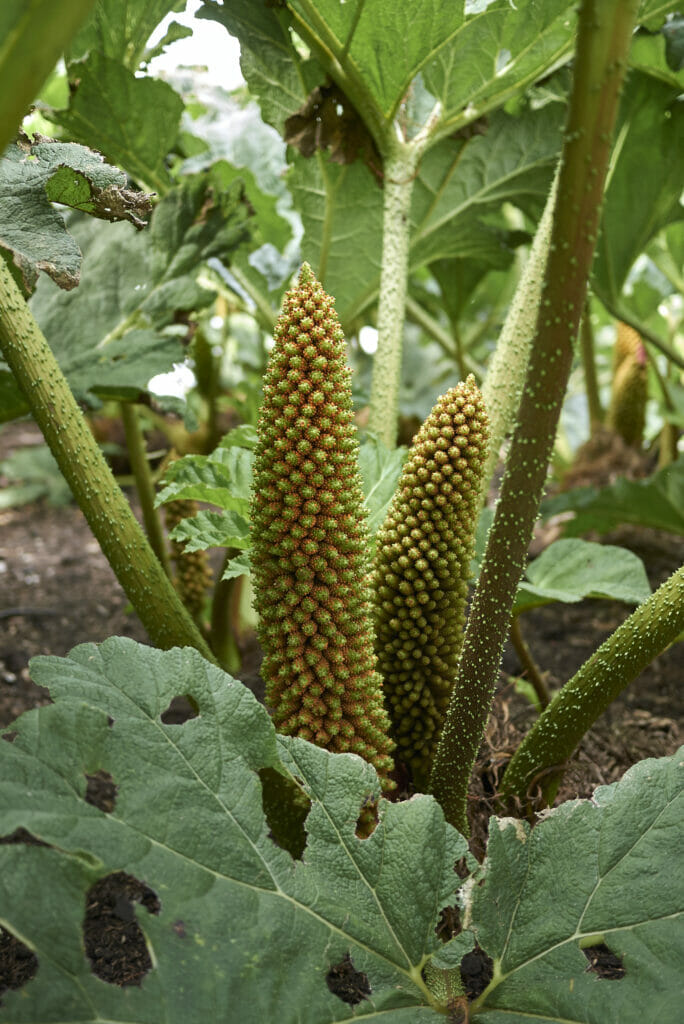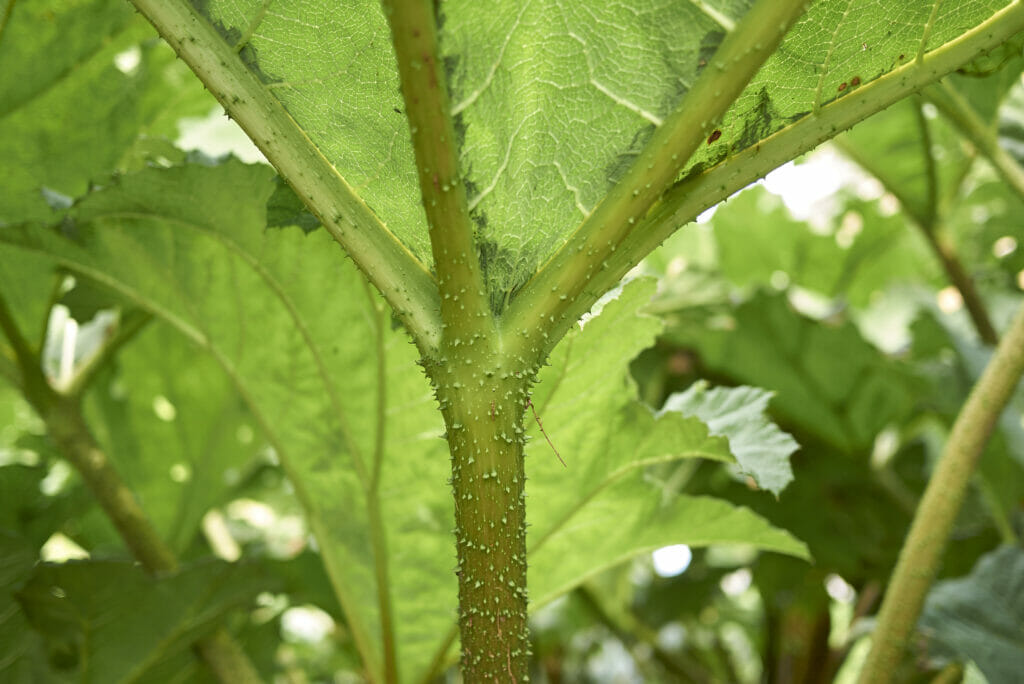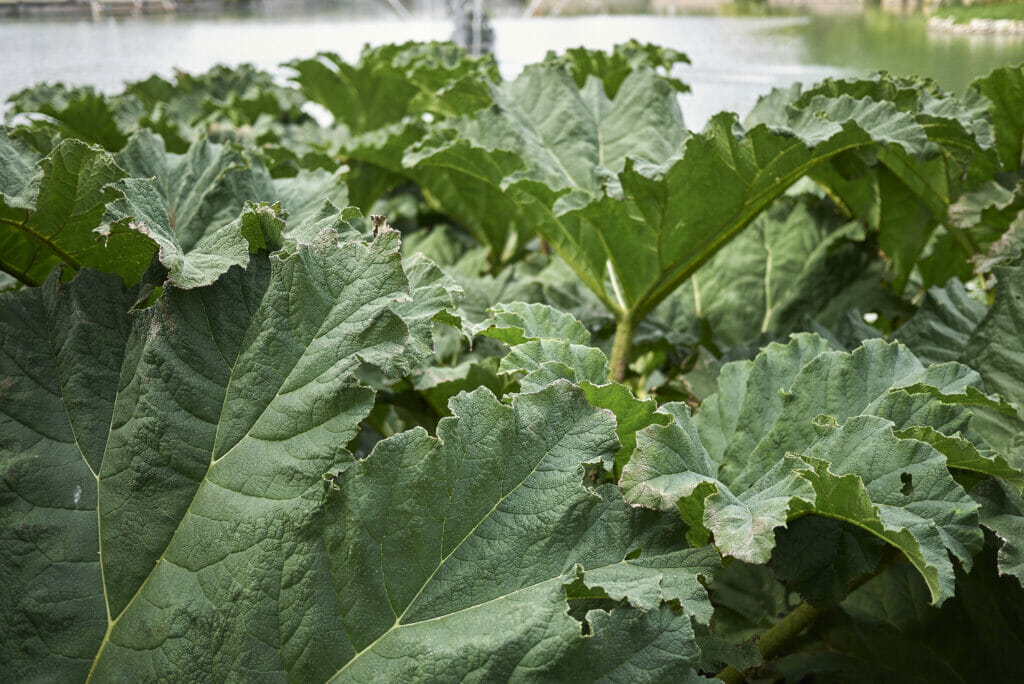Gunnera tinctoria is a magnificent architectural, herbaceous plant commonly known as ‘Giant Rhubarb’ in the UK. This is based on how similar the two species look and the commonality in their uses. Leaves can grow to an enormous 2-3 metres across and have been known to be called ‘dinosaur food’ because of their primeval aesthetic. Like many garden plants in the UK, Gunnera tinctoria is a non-native species. Its other common name Chilean Rhubarb provides the clue to its South American origins. Due to its non-native status, Gunnera tinctoria removal is sometimes considered when landscaping garden spaces especially as it has now also been classified as an invasive species in the UK. Another type of Gunnera often found in UK gardens is Gunnera manicata, a species native to Brazil that is not yet considered invasive in the UK. Identifying the differences between Gunnera tinctoria vs manicata is an important step when managing giant rhubarb removal.
Allowing Gunnera tinctoria to spread into the wild is an offence and property owners growing this plant should undertake measures to control its spread beyond their own garden’s boundaries.
What is Gunnera tinctoria?
As its common names suggest Giant/Chilean Rhubarb, or Gunnera tinctoria, has a similar growth habit to the edible, vegetable garden staple rhubarb (Rheum rhabarbarum). Gunnera tinctoria has huge, deeply veined leaves at the top of upright, robust and prickly stalks. Large, conical spikes of reddish-green flowers emerge around the base of the plant in late spring. These form dense seedheads full of an enormous quantity of viable seeds. Gunnera tinctoria grows extremely well in damp conditions, particularly along the edge of slow moving streams and ponds, or along the marshy edges of larger rivers.
It is native to Chile and Argentina, and is used in some regions as a food crop or for medicinal purposes. The Chilean Giant Rhubarb is an important plant in the Andean ecosystem. It plays a crucial role in the ecology of wetlands and riparian edges, hosting a variety of insects which feed on its leaves and stems. In the UK there are no natural controls that have co-evolved to become pests to Gunnera. While the flowers are beneficial to pollinators, there are few herbivores that rely on it for food. As such, the plant can spread with abandon, with no natural pests to constrict its population.

Gunnera tinctoria panicles (or cones), capable of producing thousands of seeds iStock.com/seven75
Are Gunnera plants banned in the UK?
A common question asked by gardeners is whether Gunnera is banned in the UK. Current regulation only restricts the sale of Gunnera tinctoria, which is banned for sale in the UK (and the whole of Europe). More than simply being a non-native species, Gunnera tinctoria is classed as an invasive species, which means it has been classified as ‘a species that can cause significant environmental and/or economic harm in its new environment’. Hence, the common debate over the planting of Gunerea tintcoria vs manicata, another variety of gunnera plant found in the UK.
Is Gunnera manicata invasive?
Other species of Gunnera brought to Europe have also been highlighted in legislation. In the Republic of Ireland, Gunnera manicata has been listed on Schedule 3 of the EU (Birds and Natural Habitats) Regulations 2011 as an invasive non-native species. Although this species is not listed as invasive in the UK, Gunnera manicata, or Brazilian Giant Rhubarb, is still a non-native plant with a rapid growth habit and the ability to spread many viable seeds. It is important to consider its ability to spread quickly, like Gunnera tinctoria, and how it can easily overwhelm the banks of a pond or wetland habitat by shading out other plants.
Other Gunneras found in the UK
Not all Gunnera are as prehistorically huge and impressive as Gunnera tinctoria and Gunnera manicata. A much smaller species called Gunnera megallanica, often considered the dwarf version, has leaves and stalks that can be measured in just centimetres rather than metres. G. megallanica is a mat-forming perennial with cupped, kidney-shaped, dark green leaves about 7cm across that sit at the top of stalks just 10cm high. In summer, short flower spikes appear bearing tight clusters of small, greenish flowers followed by orange-red berries. Gunnera megellanica is not on any invasive species lists and is available to purchase in garden centres, however, it can also take over garden spaces if not tended to properly.
Gunnera perpensa, also known as River Pumpkin, is another Gunnera species found in the UK. Gunnera perpensa is somewhere between the dwarf species and their massive cousins in size, and it has smoother fleshy lobed leaves that are less hairy. The leaves, rhizomes, roots, and stems of G. perpensa are reported to possess diverse traditional medicinal properties and have been used in many herbal concoctions and medicines. Scientific study has found the plant contains an array of phytochemicals. When investigated in vitro, Gunnera perpensa was found to have a lot of potential as a possible source of pharmaceutical products for the treatment of both human and animal diseases and ailments.

The spiked stem of Gunnera tinctoria (Giant Rhubarb) iStock.com/seven75
What does Gunnera tinctoria look like?
There are about 64 different species in the genus, but Gunnera tinctoria is the most problematic in the UK. It is important to be able to identify a Gunnera plant accurately so that gardeners can deal with Gunnera tinctoria plants appropriately. The large leaves have jagged or irregular margins and are a little darker than other varieties such as Gunnera manicata. The stalks on mature plants are reddish or purple and have green bristles. When the flower spike grows, it is a deep crimson colour, again varying here from its cousin G. manicata which has greenish yellow flowers. The flowering spike of G. manicata is a little more sprawling than G. tinctoria, and is wider than it is longer, growing nearer to the ground. Chilean Giant Rhubarb produces metre-long panicles of flowers that turn into thousands of berries that contain small black seeds that seem to have excellent rates of viability. Gunnera seeds get eaten and distributed by birds, blown on the wind, or fall into moving water to be spread in downstream eddies.
How does Gunnera spread?
There are two ways Gunnera spread, via prodigious seed production and the growth of extensive root systems that produce rhizomes. Rhizomes are a continuously growing horizontal underground stem which puts out lateral shoots and adventitious roots at regular intervals. Each node of lateral shoot can become an entirely independent plant which is a clone of the parent plant. Both Gunnera seeds and the rhizomatous growth of new plants mean that this group of plants is extremely effective at colonising new spaces.
How fast does Gunnera grow?
Gunnera can grow relatively fast when conditions are favourable. Thanks largely to its rhizomatous growth habit and prolific seeding. Dense colonies can develop rapidly over a few seasons that become difficult to eradicate once sufficiently established. Leaves start from next to nothing in February, growing to around 6ft across by June. Later, at the end of the season, the Gunnera plant will die back to ground-level crowns. Although Gunneras can take a few years to reach full maturity, they will continue to spread rhizomes throughout each growing season, spreading the colony further each year.
Are Gunnera roots invasive?
The root systems of large Gunnera species can grow up to a metre deep. The rhizomes are root-like growths that spread just under the surface of the soil to find new areas of suitable habitat to colonise. Although they are not considered as damaging as Japanese Knotweed rhizomes, they are the method by which the invasive species Gunnera tinctoria can spread very effectively, thus they should be considered invasive.
Gunnera Frequently Asked Questions
How fast does Gunnera grow?
The larger species, G. tinctoria and G. manicata, grow leaves up to 2m across each growing season.
How big do Gunnera leaves get?
Gunnera leaves can grow up to 2 meters across on stems 3 metres tall.
Does Gunnera have deep roots?
Yes, the roots can go up to a metre deep which makes them extremely difficult to excavate.
Is Gunnera poisonous?
It is not toxic to humans. Some varieties of Gunnera are consumed as food stuffs in their native habitats; primarily the stalks, which are prepared in salads or as a side dish.
Is Gunnera related to rhubarb?
No. Gunnera is not related to rhubarb. Despite their convergent evolution, these plants are from different families. Rhubarb is a hardy perennial in the buckwheat family (Polygonaceae).
How to get rid of Gunnera
Gunnera is a deciduous perennial, which means its leaves die back each winter. Due to their large leaf size, Gunneras tend to shade out other plants so that when they die back in winter the banks of the water course end up bare. Banks with no plant cover are susceptible to increased levels of erosion from the water course and winter rainfall. Large areas of Gunnera along a water course have been known to increase the possibility of flooding downstream. The risk of flooding, coupled with it being listed as an invasive species, provide compelling reasons for removing the larger Gunnera species from your land.

The Gunnera tinctoria (Giant Rhubarb) plant can often be found growing beside a watercourse iStock.com/seven75
Once the leaves have died back it is far easier to tackle digging up the crowns. However, the roots can extend up to a metre deep, and if even a small part of the rhizomes are left the plant can regrow. Herbicides can be applied to the crown though most herbicides available to home gardeners act by being absorbed by the aerial parts so may be more effective in the Spring when applied to the new growth. Caution should be taken when dealing with herbicides. Many commercially available products are not appropriate for this job, and professional grade herbicide products should only be used by a person that holds the relevant NPTC or LANTRA certificate of competence. Gunnera is frequently found beside water, spraying herbicides near water may require Environment Agency approval (an Aquaherb01), based on proximity to the watercourse and the potential to harm aquatic life. When Gunnera is growing in its preferred environment (beside water) mechanical removal is often preferred. Herbicide injection, into the root system, is also an effective method, which can be combined with excavation as part of the over plan.
Professional Gunnera removal
In the case of Gunnera tinctoria, professional removal is usually the best option. The safe handling of appropriate herbicides and the use of the most effective excavation tools is best done by trained operatives. It is also important that any soil contaminated with G. tinctoria seeds, roots or rhizomes is disposed of at a licenced waste disposal site due to the plant being listed as an invasive plant species. It is important prevent plant material entering the water course to stop its spread beyond the boundaries of the garden or land where it is present.
If you need help with Gunnera removal on your property get in contact to find out more about our invasive plant management plans. Call 0203 174 2187 or 01202 816134 to talk to one of our consultants today.
Lead image: Gunnera tinctoria iStock.com/seven75

